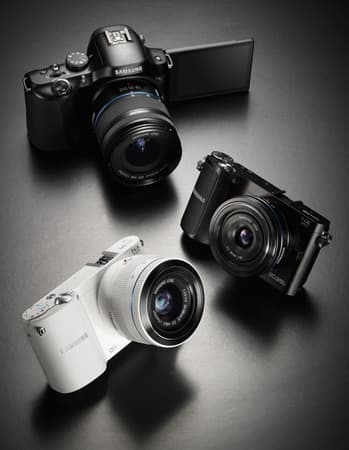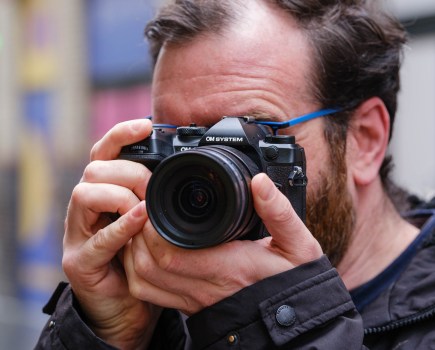Samsung is to introduce mobile internet connectivity into its NX range of compact system cameras in the Samsung NX20, NX210 and NX1000 bodies announced today.
Each will feature built-in Wi-Fi functions to allow users to connect the camera directly to the Internet in a Wi-Fi zone or via a mobile phone or tablet and post images directly to social networking sites such as Facebook, Flickr and Twitter. Users will also be able to email images directly from the camera, connect it wirelessly to Wi-Fi enabled TVs and download images automatically to a specified PC. Cloud services will provide on-line storage facilities, and the cameras will be able to connect directly to Galaxy Tab and Apple iPad type tablets for viewing, remote access and control, as well as for file transfer for later viewing.
The Samsung NX20, NX210 and NX1000 will share a modified version of the existing 20.3-million-pixel APS-C CMOS sensor used by the now discontinued NX200. Each will be able to shoot 8fps in full resolution mode, and a new raw file compression method will reduce the time the cameras take to clear their buffer memory.
Samsung UK says the NX20 and NX210 will be kitted out with the new, metal-mount, third-generation 18-55mm lens, priced £899 and £749 respectively. The NX1000 will come with a new, quieter, version of the 20-50mm collapsible lens and will cost £599. The cameras are due on sale between mid-May and mid-June.
Samsung NX20, NX210 and NX1000. Wireless features
The Samsung NX20, NX210 and NX1000 are all equipped with Samsung?s third-generation in-camera Wi-Fi system. This allows the cameras to be connected to a home Wi-Fi system or a public hotspot, but also via Wi-Fi Direct to mobile phones and tablets outside normal wireless internet zones. This allows internet access via the mobile phone network, and makes connection practical wherever a signal is available.
Being able to connect to a smart phone will allow users to not only store and send images, but the NX cameras can be controlled wirelessly via a downloadable application from Samsung. An ?app? called Remote Viewfinder already exists that connects to smart cameras, including the WB150F and DV300F, and gives the user a live view of what the camera can see from a range of about 50 metres. A new version of this app will mimic the Smart Panel control screen of the NX cameras so almost all menu items will also be accessible remotely, and when the camera is triggered images can be saved in the camera or the phone ? or both.
Cloud storage will allow connection via a hotspot or phone network to a choice of two online services, while images can be sent via email to saved email addresses. Images can be uploaded to Facebook and other social networking websites either from the home or via the Mobile Link mode when connected to a smart phone or tablet.
At home the cameras will connect to Wi-Fi enabled TVs, so images can be viewed wirelessly on the screen. Future 7000/8000-series Samsung Wi-Fi Blu-ray players will also feature hard disk storage, so images will be able to saved to these devices wirelessly. Using Auto Backup the camera can wake sleeping PCs and remotely download images to a hard drive folder automatically.
Samsung NX20, NX210 and NX1000. Sensor, sensitivity and raw files
Previous NX models have been criticised for their image noise and heavy noise reduction in images shot above base ISO settings. Although these models use the same sensor as the NX200, processing changes are claimed to produce 20% less noise and 20% more resolution. Samsung says this is down to the point at which noise is tackled. The ISO range offered remains the same as in the NX200 however, ISO 100 -128000, though this will provide an improvement for NX11 users.
The Samsung NX200 stored uncompressed raw files but the processor provided could take a long time to deal with them, leaving the camera locked as the images were passed to the card. Last month, the company issued a firmware update that enabled the camera to apply compression to the files and reduce their size by 25%, thus speeding up action times. The new cameras have this new raw format as standard, and so should also spend less time with a full buffer.
 Samsung NX20
Samsung NX20
Replacing the NX11, the new NX20 features a very similar body design as its predecessor but has a restyled and more ergonomic handgrip and a much larger eye cup on the viewfinder. The rear VGA 3in AMOLED screen is the first flip-out model in the NX range. Samsung says viewing has been improved by the filling of the air-gap between the panel and the glass cover with a UV resin that reduces internal reflections and thus boosts contrast and clarity. The company has improved the electronic viewfinder resolution from VGA to SVGA, and the introduction of a hybrid shutter system allows mechanical shutter operation up to 1/4000sec and electronic captures as short as 1/8000sec.
The camera also now features three customisable user modes on the main mode dial, so photographers can save favourite set-up combinations for particular oft-shot situations.
 Samsung NX210
Samsung NX210
The differences between the NX210 and the NX200 that came before it are slight ? other than the headline Wi-Fi enablement and the higher resolution video recording. The camera has maintained the same design as the previous model and comes bundled with the same SEF-8A flash unit.
 Samsung NX1000
Samsung NX1000
The Samsung NX1000 is clearly designed as an entry-point to the range. Made with a lightweight, plastic body it will be available in black, white or pink. It features a quick-access button called Smart Link that users can customise to access their preferred wireless settings for connection to their mobile or home internet. There is also a slightly simpler control layout on the rear of the body and more reliance on the i-Function lens-based feature-control system.
New remote cable
Samsung has introduced a new shutter remote cable that uses the mini-USB socket on the NX20, NX210 and NX1000. Styled very much like the previous mini-jack remote that the company shared with Pentax the new, optional, SR2NX02, has click and lock functions just as the older model has. This is Samsung?s first move away from the Pentax system which has been in continuous use since the film SLR days. Samsung used this mini-jack system on the GX series and the NX10, NX11 and NX100, but the NX200 features no remote control access whatsoever. Interestingly, Pentax has also not used the mini-jack system on its new compact system camera, the K-01.














